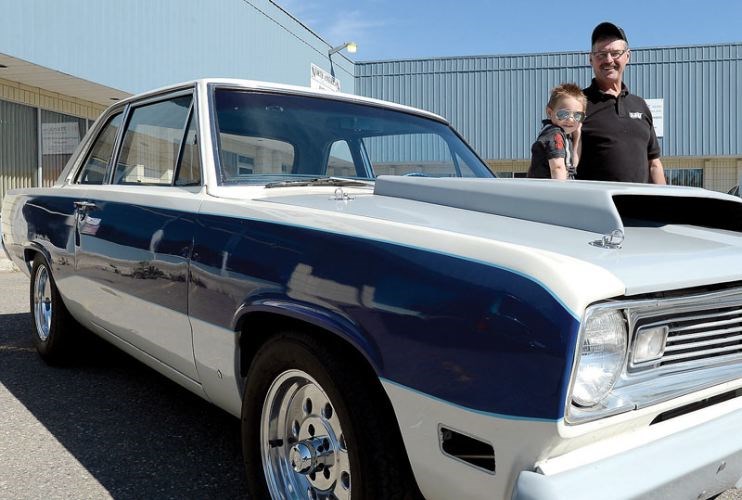Jim Wanner might be the most popular guy in the pits on race nights at Northland Dodge Motorsports Park.
That just comes with the territory when you're a master motor mechanic.
Considering he's had a hand in building the motors of a majority of the hard-core local drag racers he runs into when he goes out to race his 1969 Plymouth Valiant, Wanner has a tough time saying no when someone asks for some advice on how to make a car run faster.
Just don't ask him to bring his dynamometer to the track.
"For me, when I go out there, it's work, because we're involved with half the guys out there," said Wanner. "When you bring your own car, you can't focus on it because everybody's stealing you away and we try to accommodate them. We can do that because we're not really serious about our own stuff. It's all good."
Wanner, 64, owns Jim's Engines, a high-performance engine shop he's had in Prince George since 1978. The Estevan, Sask., native moved to Prince George in 1968 to work as a steam engineer at Intercontinental Pulp and branched off into engine building in 1974.
Four years ago, after touring several high-end motor testing shops in B.C. and Alberta, Wanner invested $200,000 in a Super Flow dynamometer, which he set up in his shop on Ongman Road.
"I wish I'd done that 20 years ago," said Wanner, who admits his machine has put the fun back into his work.
Linked to a computer, it measures and charts how much power and torque an engine will put out directly to a flywheel in simulated racing modes under variable loads, throttle positions and weather conditions. The dynamometer allows him to test how components like carburetors, distributors, fuel injection systems, crankshafts, intake/exhaust manifolds and exhaust headers affect engine performance. Through trial and error, Wanner can determine which parts work best for each individual motor.
For Wanner, it takes much of the guesswork out of fine-tuning high-performance engines used in drag cars, stock cars, mudbogging trucks and boats with inboard motors or jet engines. With a turn of a screwdriver on a carburetor jet he can chart those adjustments in real time and make comparisons to find the optimal air-fuel mixture to shave a split-second off a quarter-mile time. Before it leaves the shop, each engine is thoroughly inspected for leaks that can potentially create nightmares for racers who would have no other way of testing it under loads before it gets mounted into the car. Wanner once discovered a cracked spark plug by running an engine on the dyno with the lights off, saving the owner considerable grief.
Each motor that comes into the shop gets tested at least 15 times for six or seven seconds at full throttle. The process costs each customer about $950. Before he started racing this year, Wanner subjected his Plymouth engine to about 60 pedal-to-the metal stress tests conduced in a vented soundproofed room sheeted with triple-thick drywall.
"On most dyno runs, we'll pick up 30 or 40 horsepower and you solve a lot of issues," he said. "This thing is booked well into the fall. I could work every day if I wanted to."
Wanner's dynamometer is the only one of its kind north of Vancouver and west of Calgary or Edmonton. The brand-new 354-cubic inch Dodge Hemi engine he had in for testing when the Citizen toured his shop is owned by a Calgary car enthusiast who told Wanner he picked him because of the personal touch he delivers. Wanner worked put the bugs in the engine for two days over the winter and the owner brought it back last week to determine the right headers to install, which added another 40 horsepower.
Wanner has a long history as a drag racer. From 1970-78 he toured tracks with his Barracuda muscle car racing the NHRA super stock class but sold the car once his business started taking off. He also spent seven years racing snowmobiles. This year he ended a 10-year break from drag racing when he brought his Valiant to the local track for Friday night street legal racing.
He bought the car last year in Washington state, where it was built for everyday street use. Wanner switched it over to fuel injection and dropped in a Hemi race engine, which made it easily capable of 11.5-second, 120-mile-per-hour quarter-mile passes. Any faster than that and he'll have to install a roll bar to conform with racing rules. The driver's seat already has a backwards lean and he'll probably have to put in a proper racing seat or risk a surprise trip into the back seat when he guns the throttle.
"I'm right in the bubble for a roll a cage, I just need to be consistent," said Wanner. "It's an old car but it runs nice and straight and I'm happy with it. It's plenty safe for what we're doing. When you get older there's some self-preservation involved and you don't want to go 150 miles an hour, but 120 is OK."
Wanner says he's gotten rusty and his reaction times at the start line for bracket races aren't what they used to be. Savvy racers like Andy Closkey and Cal Barnes who are going after points titles have no trouble leaving Wanner in their tracks before they reach the finish line. They do that racing engines Wanner built.



